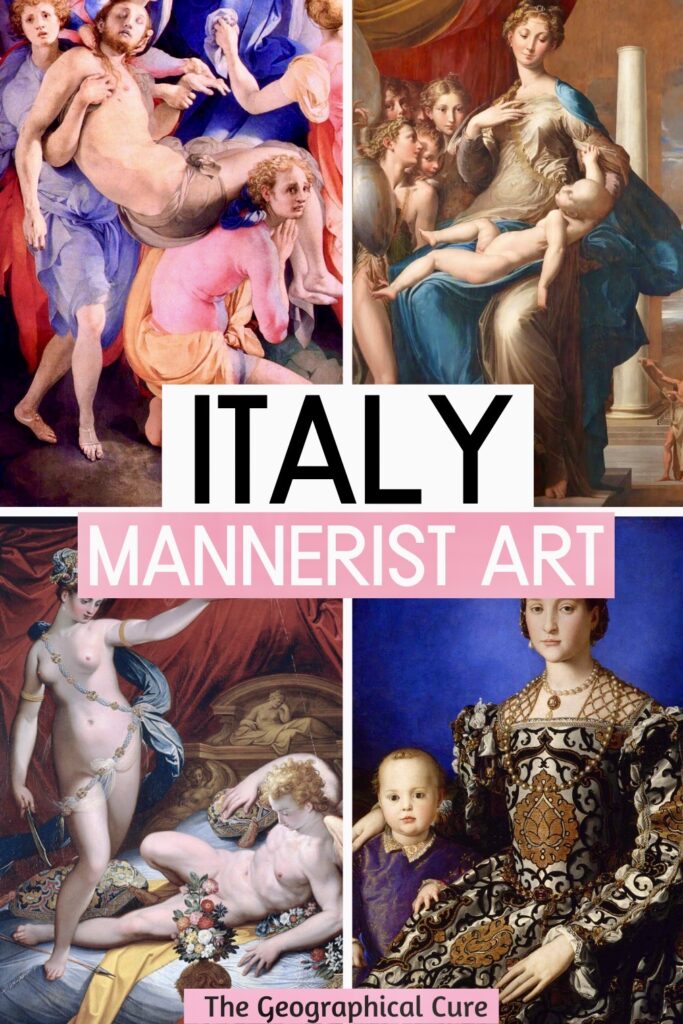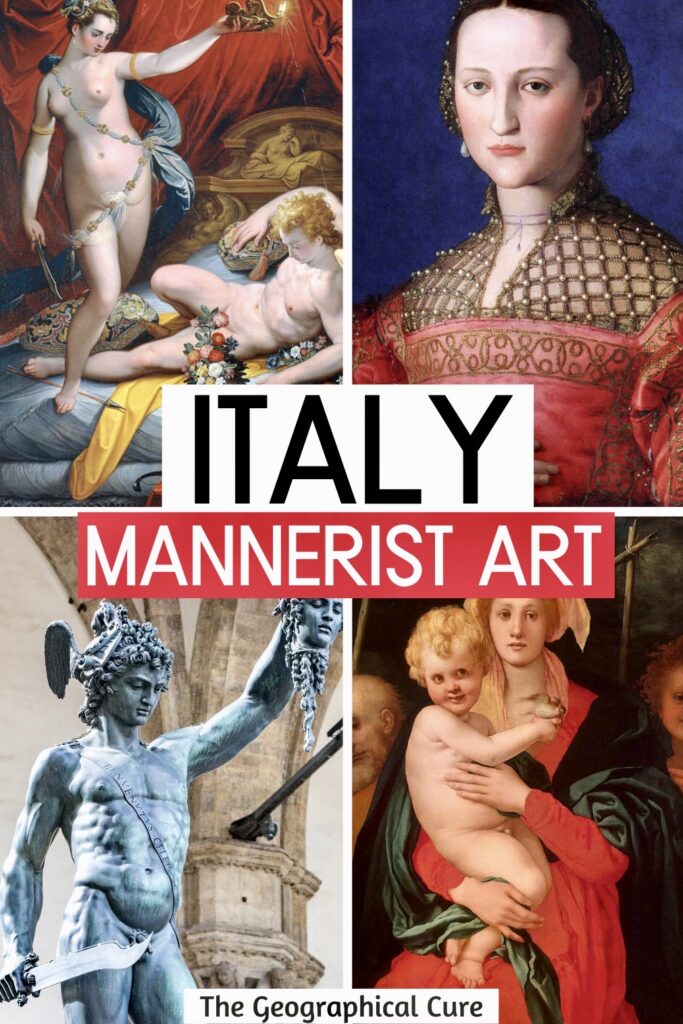Are you interested in learning more about Italian Mannerist art? Look no further than this guide! I give you an analysis of the top 13 Mannerist artworks and masterpieces produced by Italian artists.
What Is Mannerism?
Mannerism is one of the more confusing stylist movements of the Renaissance era. It was a period during the first half of the 16th century that overlapped with and followed the high Renaissance.
In fact, Mannerism is one of the first “isms” in art history. It was the first time that a group of artists produced art in a very specific and distinctive way.
Mannerism is often considered a sub-category of the Renaissance. But, in reality, it was a reaction against its strictures.
Renaissance artists aimed to create art that closely resembled nature. Mannerists, on the other hand, had a very different vision of what art should be.
They were tired of the Renaissance’s focus on objectivity and harmony. Instead, the Mannerists rejected the prevailing art rules and brought a subjective interpretation and artifice to their artworks.
They introduced a new style of art that produced some unusual creations. Some were truly bizarre.
Despite the quirky nature of their creations, Mannerist artworks are often described as zany, fun, and deliberately unconventional. Some even liken the style to jazz.
Mannerist artworks are characterized by a vivid color palette, elongated and exaggerated proportions, odd figurative poses, unnatural elegance, and elaborate compositions.
Some historians claim it was a self conscious “style based on style.” It was “mannered” art — a highly sophisticated art for a highly sophisticated age.
Who was the father of Mannerism? Some would say it all began with Michelangelo. He was already breaking Renaissance rules in painting with his The Last Judgment fresco in the Sistine Chapel and in architecture with the Laurentian Library.
After Michelangelo, Florentine artists paved the way. Those artists included Rosso Fiorentino, Pontormo, and Bronzino. Parmigianino from Parma also joined the fray.
At first, Mannerism was roundly deried and considered tasteless. Art historians brushed it off as a clumsy period. But that consensus has been reevaluated, with experts concluding that the Mannerist contributons were significant.
Famous Italian Mannerist Artworks
Here are 13 must see works of Mannerism by Italian artists. I also tell you where to find them. Most, but not all, of these famous Italian Mannerist pieces are in Italy.
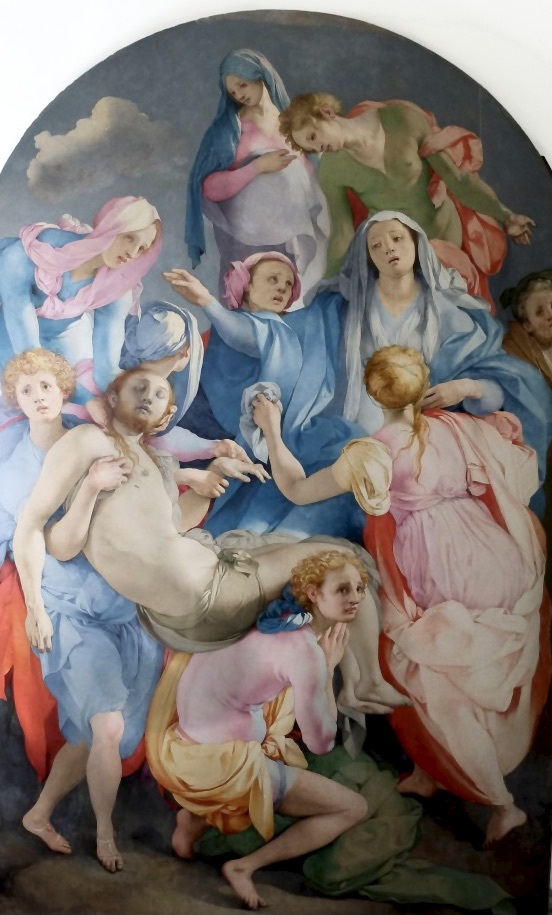
1. Pontormo, Deposition from the Cross
Jacopo Pontormo was a prominent Italian Mannerist painter whose masterpiece is the Deposition. This famous Mannerist painting in Italy was created after he had seen Michelangelo’s frescoes in the Sistine Chapel, and was heavily influenced by them.
The Deposition is the focal point of the Cappella Capponi, which is located in Sant Felicita Church in Florence. It’s a powerful and emotive work that depicts the aftermath of Christ’s crucifixion.
His body is being taken down from the cross and prepared for burial. The painting is striking for its use of unnaturally bright pastel colors, dramatic lighting, and stylized forms.
Oddly, the painting does not feature a cross, blood, dirt, or crown of thorns, making it quite different from traditional depictions of the crucifixion. In fact, it could almost be a pieta. The figures are portrayed in twisting and tangled forms.
Interestingly, the painting also features a self-portrait of Pontormo in the far center right. Just to the right of the Deposition is the Annunciation, another exquisite fresco by Pontormo that is more restrained in its style.
Where to find it: Florence, Church of Santa Felicita
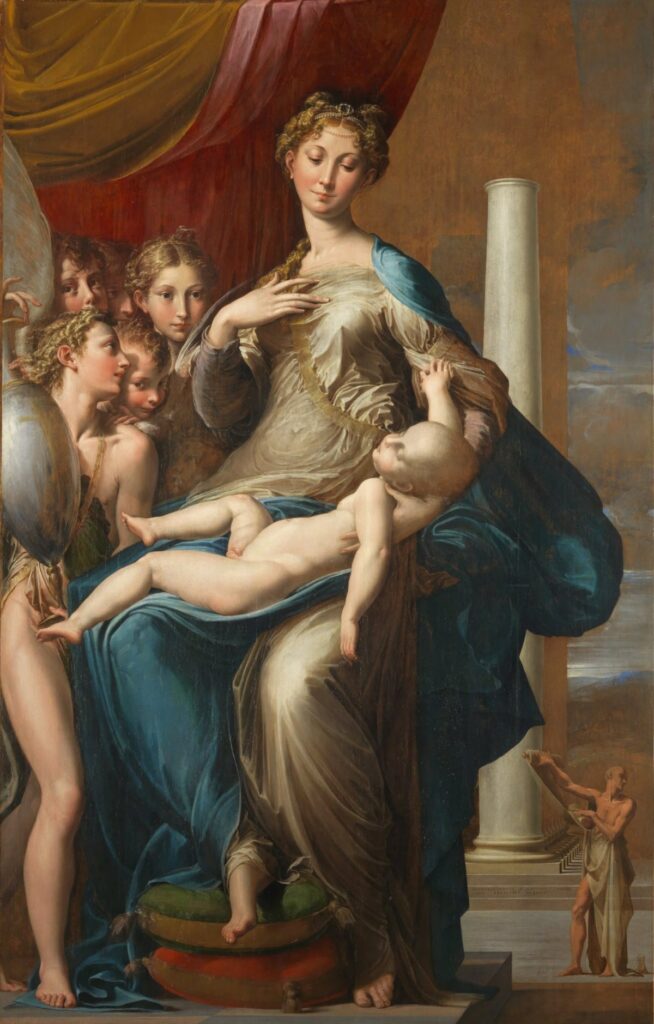
2. Parmigianino, Madonna with the Long Neck
The Madonna with the Long Neck is a Italian Mannerist masterpiece created by the Parmigianino. The elegant painting features the standard representation of madonna and child with angels, but is anything but standard.
Mary is depicted as a regal figure on a high pedestal wearing lavish attire and holding baby Jesus on her lap. They are surrounded by six angels.
The painting convolutes basic anatomy. It has elongated figures, distorted perspectives, and a dreamlike surreal quality. The figure of the Virgin Mary is particularly absurd, with an impossibly long neck, long legs, and swollen belly.
The painting also features one of the most un-babyish babies of Italian art. Though a newborn, Jesus looks over 2 feet tall, most of that height in his long skinny torso.
In fact, the infant looks like he is about to slide to the floor. You might not even notice this impending mishap because you’re too busy gaping at Mary’s long neck.
Where to find it: Florence, Uffizi Gallery
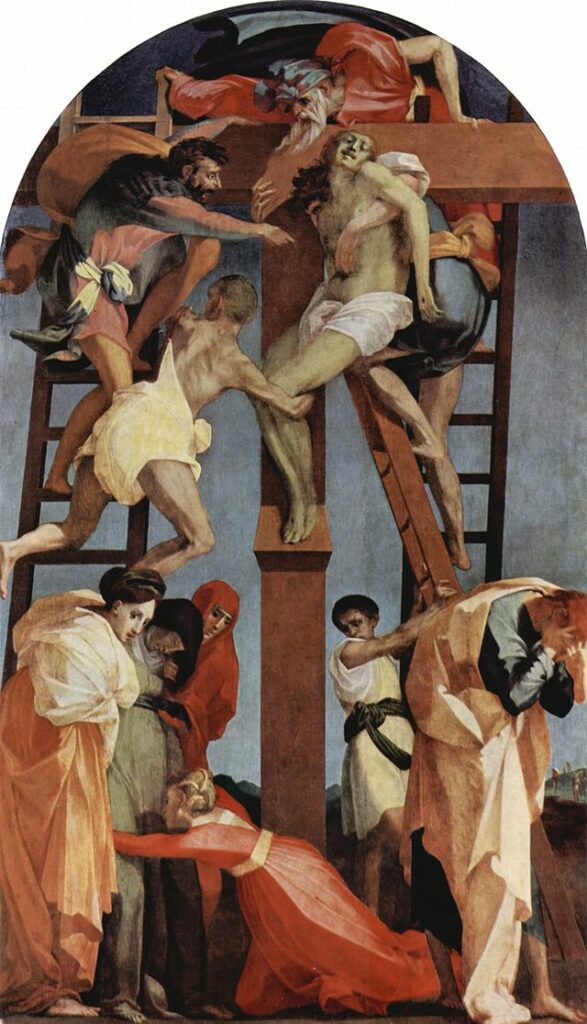
3. Rosso Fiorentino, The Descent from the Cross
Rosso Fiorentino’s Descent from the Cross is considered a masterpiece of Italian Mannerism. His unconventional works reflect a total breakdown of the Renaissance principle of harmony.
The Descent, for example, features highly stylized figures that deviate from the idealized forms. They are elongated, twisted, and contorted, with exaggerated poses and expressions that convey a sense of drama and emotion.
The painting displays a highly individualistic approach to color and composition. Fiorentino used bold and unconventional colors, such as bright reds, blues, and greens.
He arranged the figures in a complex, asymmetric composition that defied traditional principles of balance and symmetry. The result is a highly dynamic and visually striking composition that captures the viewer’s attention.
The painting also contains a range of symbolic elements and references that reflect the intellectual and cultural interests of the Mannerist period. For example, Fiorentino included classical motifs and allegorical figures, which allude to themes of mortality, salvation, and redemption.
Where to find it: Volterra, Civic Museum
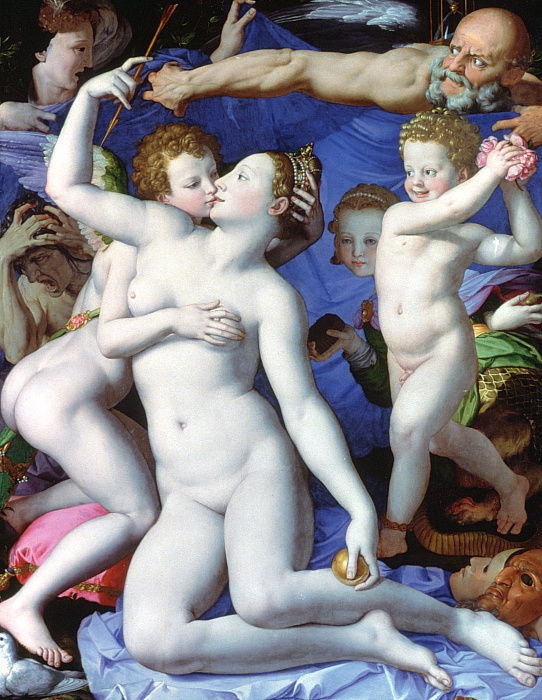
4. Bronzino, Allegory of Love: Triumph of Venus
Bronzino was the prize pupil of Pontormo. The artist became famous as a portraitist of the Medici duke and duchess.
His racy Allegory of Love is one of the most famous Mannerist paintings from Italy and has long fascinated art historians. It’s an erotic painting that almost appears like a glossy fashion magazine.
As a painting produceed for the court, it likely intentionally incorporated a puzzle and emblematic mythological figures. Unraveling the symbolism was half the fun after all.
The painting is a scene of unchaste love, set against an intense ultramarine blue. The figures are cold as enamel.
The goddess of love is identified by an apple and holds Cupid’s arrow. A laughing child throws petals at the pair. Amidst them are the figures of deceit, Father Time, Jealously, and Oblivion, who testify to the bad results that come from lust.
Where to find it: Washington D.C., National Gallery of Art
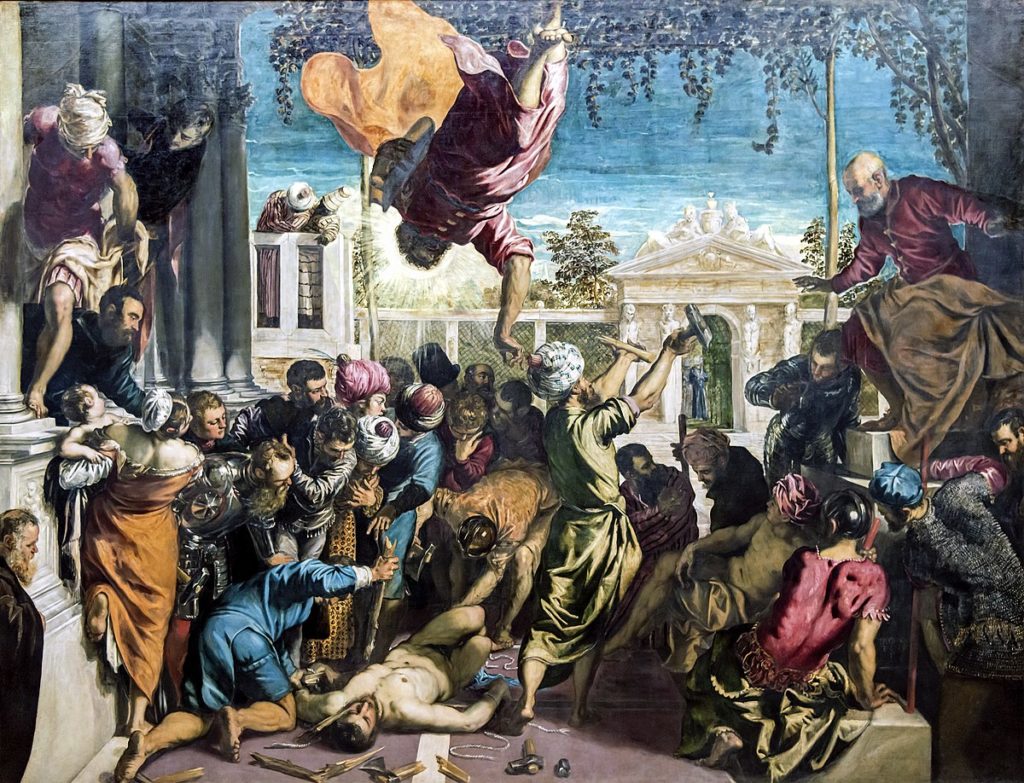
5. Tintoretto, Miracle of the Slave
This Tintoretto painting is part of his St. Mark cycle and portrays one of the saint’s posthumous miracles.
The story goes that a knight’s slave in Ancient Rome was discovered to be a Christian. As a result, the knight decided to torture and kill him. However, the slave prayed to St. Mark, who intervened and saved him from his gruesome fate.
In the painting, we see the slave in a dramatically foreshortened position, which emphasizes his vulnerability and the violence of the situation. The executioner is depicted with dirty feet, adding a touch of realism to the scene. He holds a large wooden stake, suggesting the brutality of the impending execution.
The background of the painting is enigmatic. It appears to be a Venetian garden, adding an air of mystery to the composition. Tintoretto’s use of light and dark adds to the intensity of the scene, with the dramatic contrast between the bright, illuminated areas and the deep shadows.
Tintoretto’s style was daring and innovative for the time. In this painting, his brushstrokes are broad and almost impressionistic.
This technique was criticized by art historian Giorgio Vasari, who accused Tintoretto of painting with a “broomstick.” However, Tintoretto’s bold Mannerism style was highly influential in the development of the Baroque style of painting.
Where to find it: Venice, Galleria dell’Accademia
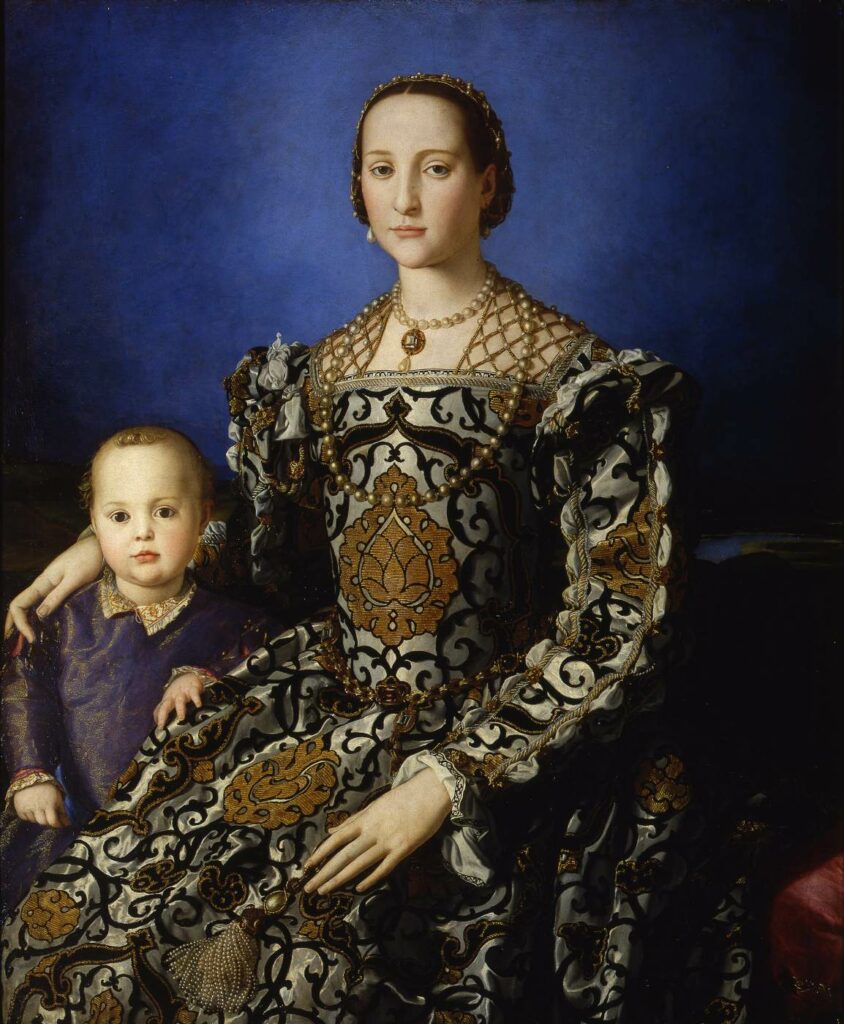
6. Bronzino, Eleanor of Toledo
As I mentioned above, Bronzino was a prominent Mannerist painter in Florence, renowned for his skillful portraiture. He developed his own unique linear style, influenced by artists such as Michelangelo and Raphael.
The subject of this portrait is Eleonora of Toledo, the wife of Cosimo I de’ Medici, who bought the Pitti Palace. It’s believed that the young boy standing by her side is the couple’s middle son, Giovanni, based on the painting’s date.
Despite being an official portrait, Bronzino captures an affectionate moment between mother and child in a landscape setting. He meticulously depicts their features and their elaborate clothing, which is adorned with a pomegranate motif symbolizing motherhood.
According to art historian Deborah Parker, the ornate silk dress itself can be interpreted as a symbol of Eleonora’s power and status. Overall, the portrait showcases Bronzino’s skillful attention to detail and his ability to capture intimate moments in a grand and elaborate manner.
Where to find it: Florence, Uffizi Gallery
7. Paolo Veronese, Wedding Feast at Cana
Veronese’s The Feast in the House of Levi is an iconic Mannerist painting that’s the largest painting in the Louvre. It’s massive, measuring an impressive 43 feet in width. The painting is renowned for its grand architecture, intricate detail, and unbridled chaos.
While the subject of the painting is The Last Supper, Veronese’s interpretation veers far from a traditional biblical depiction. Instead, the painting showcases a hedonistic feast with an assortment of drunken characters, jesters, and revelers in a triple-arched loggia.
Christ is positioned at the center, with Saint Peter and Saint John flanking him. Judas is portrayed as nervous and fidgety across from Christ in a red robe.
A dog and a cat, symbols of the devil, can be seen sitting at their feet. The painting became infamous for its racy and indecorous nature. And the Inquisition censured Veronese for mocking the holy meal.
When summoned before them, Veronese refused to make any changes, claiming artistic license. Instead, he changed the title of the painting to appease the Inquisition.
Where to find it: Paris, Louvre
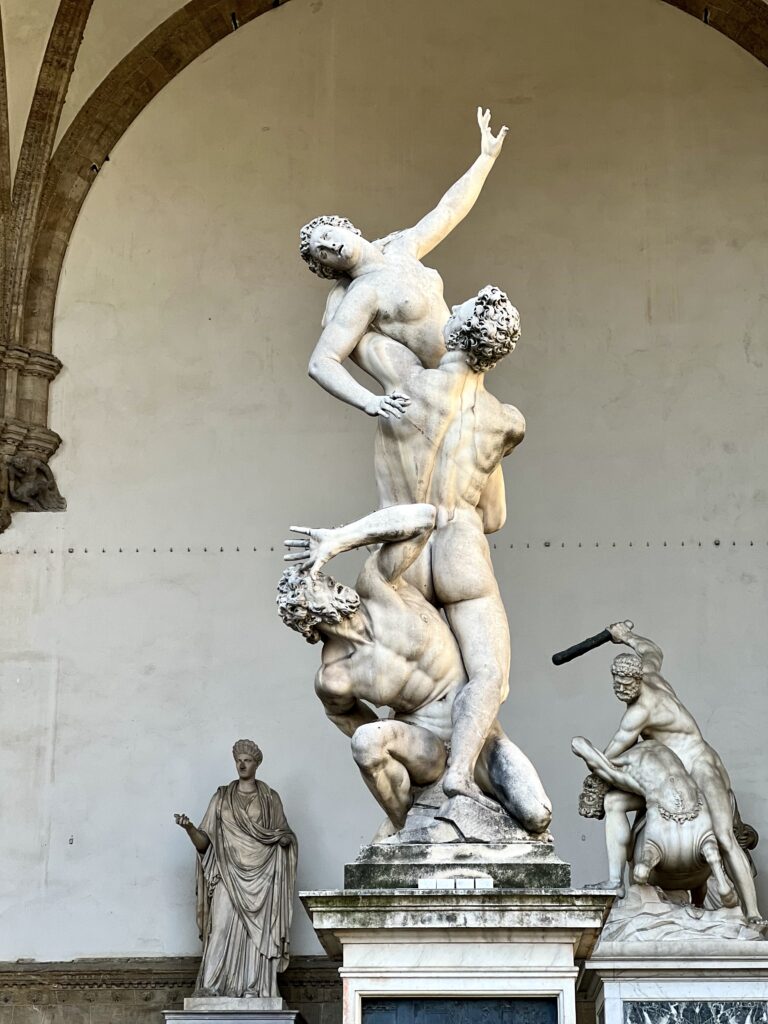
8. Giambologna, Rape of the Sabine Women
Giambologna was a court sculptor to the Medici. He was the most important sculptor in Florence after Michelangelo and the greatest sculptor of the second half of the 16th century.
Though influenced by Michelangelo, he developed his own Mannerist style. It featured graceful curves, sinuous lines, and exaggerated poses.
The Rape of the Sabines is the artist’s signature masterpiece. It depicts three figures in a serpentine-like movement depicting part of the foundation myth of Rome.
READ: Nutshell History of Ancient Rome
A Roman man captures a Sabine woman as he marches over a vanquished Sabine man. The woman twists backward as she’s hoisted in the air.
Interestingly, the sculpture had no name when it was first created. But Giambologna’s patron insisted that it have a theme, and he chose the rape of the sabines rather randomly.
The sculpture is displayed in the Loggia dei Lanzia in Florence’s Piazza della Signoria. It’s been recently cleaned and restored. Still, it’s being damaged by exposure to the elements. Hopefully, Florence will find the funding to bring the statue inside soon.
Where to find it: Florence, Piazza della Signoria
9. Cellini, Perseus with the Head of Medusa
Cellini’s Perseus is a renowned Italian Mannerist sculpture created by goldsmith and artist, Benvenuto Cellini. Commissioned by the Medici family for the Piazza della Signoria, it was their way of paying homage to their founding father, Perseus.
The large sculpture depicts a muscle-y Perseus saving Athens from Medusa’s petrifying gaze. Afterbeing raped by Poseidon, Medusa was transformed into a monstrous creature with hair made of snakes. Anyone who looked at Medusa turned to stone.
In Cellini’s rendition of the ancient myth, Perseus suceeds in tricking Medusa. He vanquishes her with a phallic sword and holds her severed head aloft in triumph.
Cellini’s statue was so large and its composition so complex that it took the artist nine years to complete Perseus. The artist signed his name across Perseus’ sash, much like Michelangelo signed his Pieta at St. Peter’s Basilica in Rome.
Interestingly, Cellini placed a portrait of his lover on Medusa’s head, whom he tricked into posing for him, much to her dismay. Cellini also included his own bearded portrait between the wings of Perseus’ crown.
Where to find it: Florence, Piazza della Signoria
10. Giulio Romano, Fall of the Giants
Giulio Romano was the star pupil of Raphael and a leading artist in Mantua and Rome. He was known for his dramatic Mannerist style, often depiciting mythological and allegorical themes in his work.
Romano’s masterpiece is his theatrical frescos in Mantua’s Palazzo Te. The palace was the bling-y summer palace of the Gonzaga family.
Romano’s piece de resistance is the Fall of the Giants in the Hall of the Giants. Within this awe-inspiring grotto-like space is an alternate Mannerist fantasy realm. Colossal elongated figures adorn every inch of the walls.
The intense frescos depict the epic tale of the titans’ downfall, as narrated in Ovid’s Metamorphoses. Polyphemus and his grotesque comic-book-like giants audaciously dare to ascend Mount Olympus.
In response, the gods unleash their fury in a temptestous storm. They obliterate the giants, hurling pillars and lightening bolts. The scene is so vivid that you may have the sensation of being crushed yourself.
Where to find it: Manuta, Palazzo Te
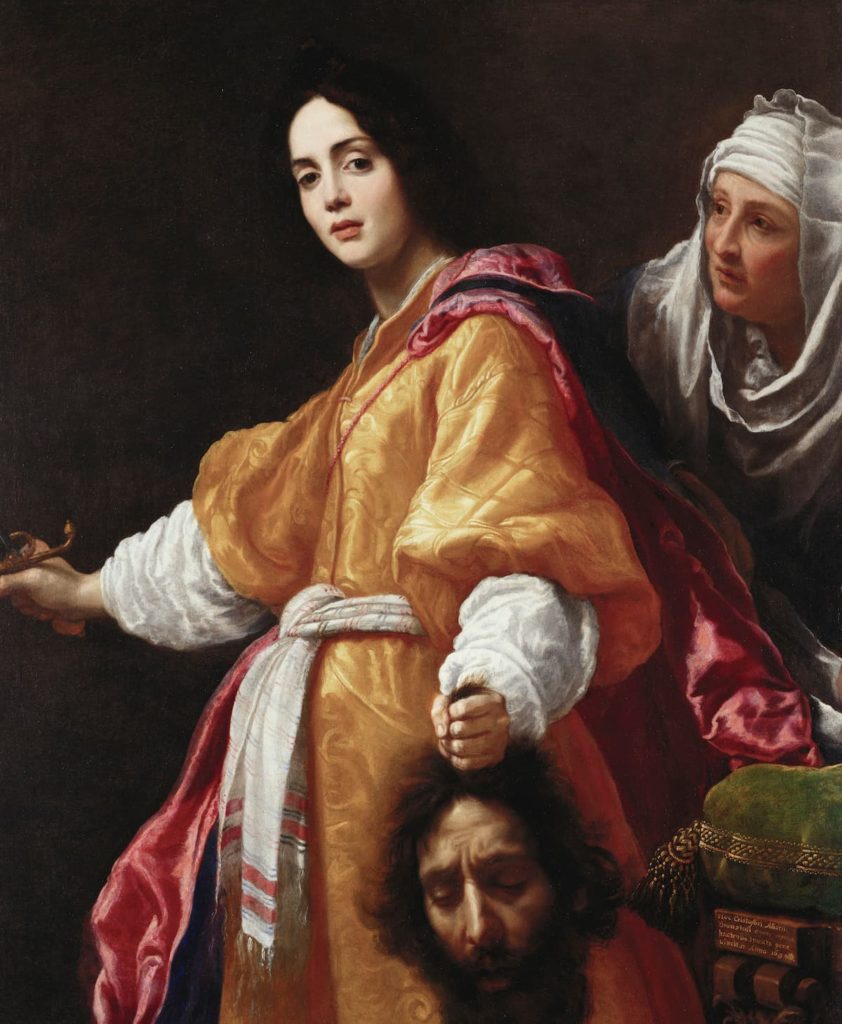
11. Cristofano Allori, Judith with the Head of Holofernes
Cristofani Allori was the son of the proflific Mannerist paitner Allessandro Allori. He’s most recognized for his captivating masterpiece titled Judith with the Head of Holofernes, which is one of the most famous paintings of the 17th century.
The painting masterfully captures the dramatic essence of the popular biblical account of Judith and Holofernes. In it, a courageous woman takes matters into her own hands, beheading the tyrannical warlord who has laid siege to her hometown in Israel.
In Allori’s interpretation if the tale, a willowy Judith exudes an air of serene composure, adorned in a resplendent golden gown. Her gaze is fixed upon the viewer as she presents the severed head, symbolizing her triumphant act of heroism.
What sets this painting apart is its remarkable fusion of beauty, violence, and emotional intensity, effectively conveying a tale of separation and empowerment. Interestingly, Allori infused personal elements into his work.
He modeled the face of Judith after his former lover, an individual with whom he had experienced a tumultuous relationship that ended unfavorably. The head of Holofernes is a self-portrait of Allori himself, adding a unique autobiographical dimension to the artwork.
Where to find it: London, Buckingham Palace
12. Giorgio Vasari, Portrait of Lorenzo de’ Medici
At the young age of 22, Giorgio Vasari painted this portrait of the renowned Lorenzo de’ Medici. It was commissioned by Cosimo I de’ Medici as a tribute to Lorenzo, known as Il Magnifico.
Lorenzo was the most prominent ruler of the Medici dynasty. He was an incredibly important patron of Renaissance art. He generously supported renowned artists such as Michelangelo, Botticelli, and Donatello.
In Vasari’s portrait, Lorenzo is depicted wearing a blue tunic adorned with ermine cuffs, surrounded by objects that celebrate his reign. A red purse, symbolizing his role as a banker to the pope, hangs from his belt.
The painting portrays Lorenzo in a contemplative manner, presented with humility in subtly muted colors. His moody and unshaven appearance was purposefully chosen to depict him as a man of the people, underscoring his connection to the masses.
Vasari is also well known for his frescos in the Hall of the Five Hundred and Apartment of the Elements in Florence’s Palazzo Vecchio.
Where to find it: Uffizi Gallery, Florence
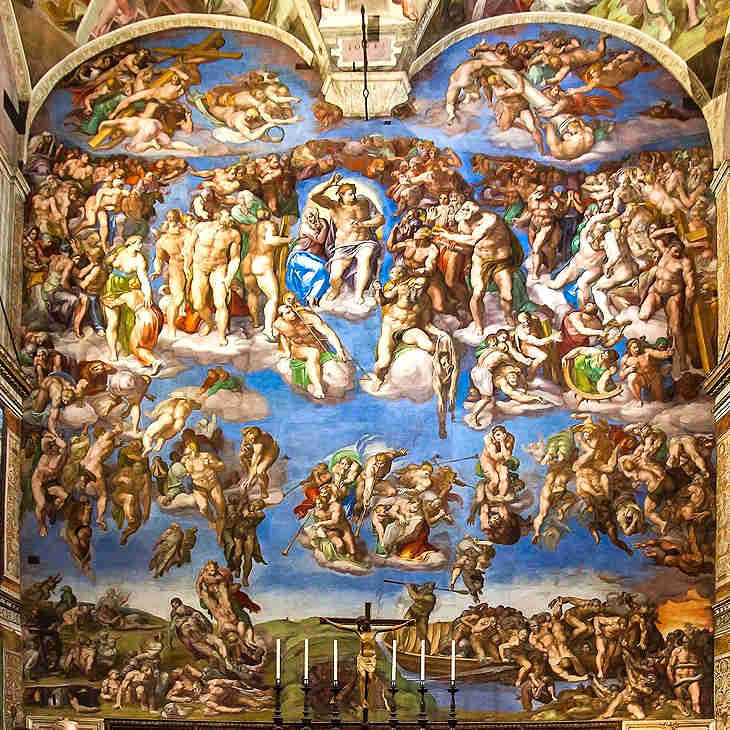
13. Michelangleo, The Last Judgment
The Last Judgment could either be considered the last flourishing of the high Renaissance or the first major example of Italian Mannerist painting. I’m choosing to treat it as the latter because it’s so different than Michelangelo’s other frescos in the Sistine Chapel.
In 1536, Pope Clement VII summoned Michelangelo to paint The Last Judgment on the altar wall of the Sistine Chapel, 24 years after he had finished the ceiling. Michelangelo was 61 at the time and worked alone on the project for five years.
The fresco is a powerful and terrifying composition, set against an azure blue background. It depicts over 300 figures, the majority of which are nude.
The Last Judgment is rendered in a different style than Michelangelo’s prior ceiling frescos, essentially kicking off Mannerism. The figures are more monumental and are in distorted positions.
The fresco has an anxious restlessness and uncertain feel. Each figure is depicted in a heightened emotional state, adding to the overall intensity of the scene.
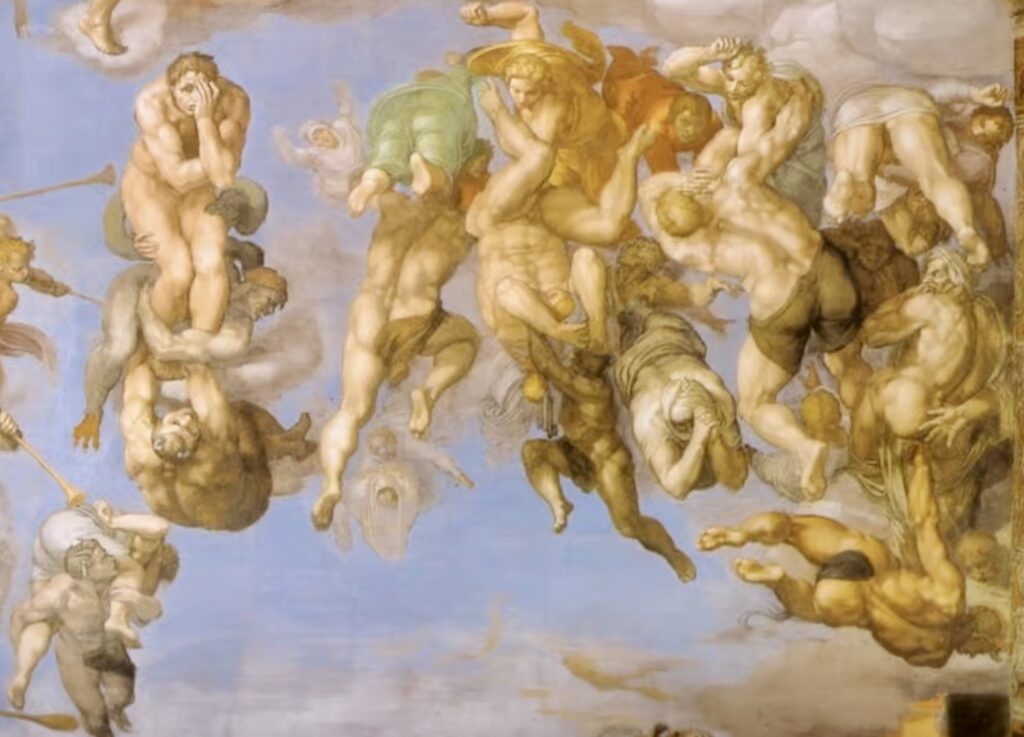
Christ is depicted differently than usual in the middle of the composition. He appears excessively youthful, buff, and smoothly shaven.
He floats on clouds like Apollo rather than appearing as the suffering bearded savior one usually expects. His raised hand casts judgment against the damned.
Completing The Last Judgment was a difficult task for Michelangelo as he was a senior citizen at the time. It’s rumored that he hid two dour self-portraits in the fresco, perhaps as a way of depicting his unhappiness at being forced to undertake the project.
Where to find it: Vatican City, Sistine Chapel
READ: 20+ Famous Sculptures by Michelangelo
I hope you’ve enjoyed my guide to the masterpieces of Italian Mannerism. You may enjoy these other Italy travel guides and resources:
- 3 day itinerary for Rome
- 5 day itinerary for Rome
- 1 day itinerary for Vatican City
- 3 day itinerary for Florence
- 2 day itinerary for Venice
- 1 day itinerary for Milan
- 1 day itinerary for Siena
- One week in Umbria
- 10 days in Italy itinerary
- 10 day itinerary for Tuscany
- 12 ways to spend 1 week in Italy
- 2 weeks in Sicily itinerary
If you’d like to discover famous Italian Mannerist artworks, pin it for later.

